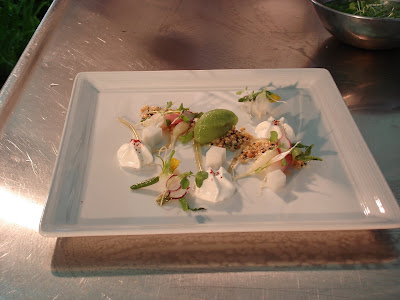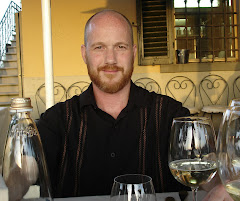
Lee Ann Wong graced the stage next with Chef Jeremy (also of the French Culinary Institute) to perform a mixology demo. She discussed molecular gastronomy research at the French Culinary Institute and a man named David Arnold, Director of Culinary Technology. Their mission is to learn how science and technology can improve the taste of food. I took this to mean, improve the enjoyment of food. For the mixology demo they prepared a cocktail of celery vodka with clarified grapefruit. Some fascinating techniques were at play here. First, to clarify the grapefruit, they dissolved gelatin in a small amount of grapefruit juice (to insure dissolution) and then mixed it with a large quantity of juice to make a solution that was .5% gelatin by weight. This they frozen and, finally, slow thawed over a fine meshed cloth. The gelatin binds all the solids (impurities) as it freezes. Slow thawing draws out a raw, crystal clear juice, leaving the impurities and gelatin behind. Very cool. She demonstrated all these steps, yet had product ready to represent each stage. The clarified juice is cocktail-ready. Next, she used a sous-vide machine (really a kryovac machine, a machine designed to vacuum pack foods in plastic) to decompress a pan of vodka and raw, sliced celery. She mentioned it is critical to keep all components as cold as possible before, after and during the process. In fact, she recommends storing the infused vodka in the freezer. Otherwise, high temperatures will cause the flavors to "brown out." The machine is run until it reaches zero atmosphere. The air in the celery is sucked out. It actually looks exactly like the vodka is boiling. When most of the air is sucked out the bubbles become slowed and fine. At this point the machine is shut off. The vodka celery mixture is allowed to sit at zero gravity for one hour. Then the machine is turned back on and allowed to finish its cycle. This process is repeated once to draw the vodka back out of the celery. The resulting infusion is strained through a coffee filter and kept very cold.
Here is Lee Ann Wong working the kryo-vac machine.

Lee Ann Wong then discussed some other mixology applications of this process, including one of her personal favorites, infusing gin with cucumber. She saves the cucumber and serves it as a "boozy snack." Yum.

Lastly, Chef Paul Del Favero of Bobby Flay's Mesa Grill at Caesars Palace. Faveros demonstrations was the most traditional, using no techniques borrowed from the realm of molecular gastronomy. He discussed the running of a kitchen that does between twenty to twenty-five thousand covers a month. Mind boggling. The food was simple and beautiful: fried zucchini blossoms stuffed with house made ricotta, corn and basil on a pools of yellow bell pepper coulis, spiked with habaneros, a starter that has remained on the menu since the inception of the restaurant. Thanks, Paul, for brining us back down to earth with this beautiful dish.


















































